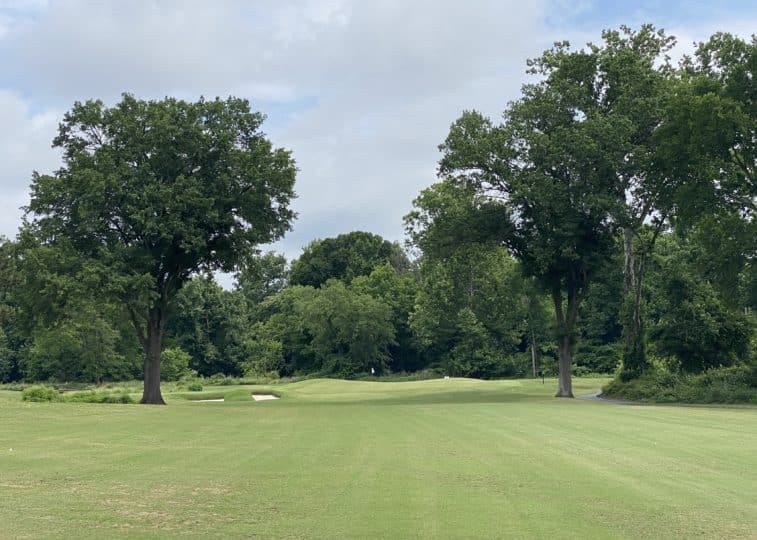Belmont
By Matt Ginella
Belmont is a microcosm of golf in America: a private gem in Virginia built in the “Golden Age of Architecture” and host of a PGA Championship (Sam Snead, 1949) gets bought by a municipality, which, over time, mismanages it into a strain on taxpayers. But just before the hyenas and buzzards in business suits are about to move in and finish off the carcass, community leaders storm in with passion, conviction and cash to save the day.
In some cases, the course gets much-needed tender loving care. In Belmont’s case, it got Love Golf Design, which did a little restoration, some renovation, but mostly reimagination.
Davis Love III won a PGA Championship at Winged Foot, an A.W. Tillinghast design, with his brother, Mark, on his bag. Now 25 projects into their careers as architects, the two have teamed up again at Belmont to restore 12 holes of Tillinghast’s original design, which dates to 1917. The Loves also took six of the original holes and used the footprint to build a six-hole par-3 course, a putting course and a driving range. And thus they reimagined a modern business model of public golf and the way the game is consumed.
“It was special,” says Mark Love, who also played a lot of golf at Winged Foot. “To get an opportunity to work on a course designed by an architect who helped drive our passion for the game. There’s obviously pressure to do the right thing, but we looked at it more as a challenge.”
The Love brothers, along with Scott Sherman (the more technical engineer of the team), redesigned the University of Virginia’s Birdwood Golf Course in 2016. Belmont, which is still owned by Henrico County but is now being leased and managed by the First Tee of Greater Richmond, reopened in May 2021. And this week, Davis Love is competing at the PGA Tour Champions event at the Country Club of Virginia, which is 15 minutes down the street from Belmont.
As you’ll see in our recent Journey to Richmond, I had the chance to play the 12-hole course with Eugene Thomas, who’s on the board of directors for the First Tee of Greater Richmond, and Matt Goodwin, who was a significant contributor to the $5.1 million that was raised to cover the costs of the work. Our fourth was Vinny Giles, who at 78 is one of the most accomplished amateurs to play the game: the winner of the U.S. and British Amateur Championships (1972 and '75); low amateur at the 1968 Masters; competitor on four winning Walker Cup teams; and at 66, the winner of the 2009 Senior Amateur Championship. No wonder Giles, a seven-time state Open champion, was part of the inaugural class of the Virginia Golf Hall of Fame in 2016. Giles used to play Belmont in the late '60s, when he graduated from the University of Virginia Law School, back when Belmont was Hermitage Country Club.
“They were about to turn this into a park,” Giles told me. “And with the support of the First Tee, the Goodwins and Fred Tattersall, they brought back more than a golf course—they brought back an eight-door entertainment center. They’re going to keep kids, and people in general, very active in golf.”
Giles kept us all active in reaching for our wallets that day. I felt honored to settle the debt. As for green fees, to play Big Bell, the 12-hole course, it’s $35 on weekdays, $40 on weekends. To play Little Bell, the par-3 course, it’s $10. Juniors pay half of those rates. Kids involved in a First Tee program play for free. And according to Mark Love, what has become popular is to play Little Bell and then roll right into a round on Big Bell, which results in a fast and fun 18.
“It panned out the way they envisioned it,” says Mark Love. “All we hear about is how much fun people are having playing it. Those options—long course, short course and putting course—that’s a formula that will draw more people into the game.”
Which brings us to yet another Keiser story.
Love says he and Davis had recently visited Sand Valley in Wisconsin and spent time with Michael Keiser, the son of Mike Keiser, who built Bandon and Cabot. Keiser’s sons, Michael and Chris, are overseeing the development of Sand Valley, which now has a course by Bill Coore and Ben Crenshaw (Sand Valley, 2017), one by David McLay Kidd (Mammoth Dunes, 2018) and Tom Doak is in the midst of re-creating the Lido Course, a 1914 C.B. Macdonald masterpiece that got churned up by war demands on land. Love says he and his brother were blown away by the quality of the golf, the hang and the vibe. At dinner, they chatted with 13 women who, yes, wanted a picture with his famous brother, but Mark Love was also struck by their itinerary. The women told him they had driven over from Madison that day, which is almost two hours away. They spent the entire day playing the Sandbox—Sand Valley’s charming 17-hole par-3 course—and then they were driving home after dinner.
Love was inspired: “Golf needs more of that!”
And thankfully, golf in America is getting more Belmonts: accessible and affordable community assets that provide a variety of options and are utilized by a diverse clientele.
—Matt



